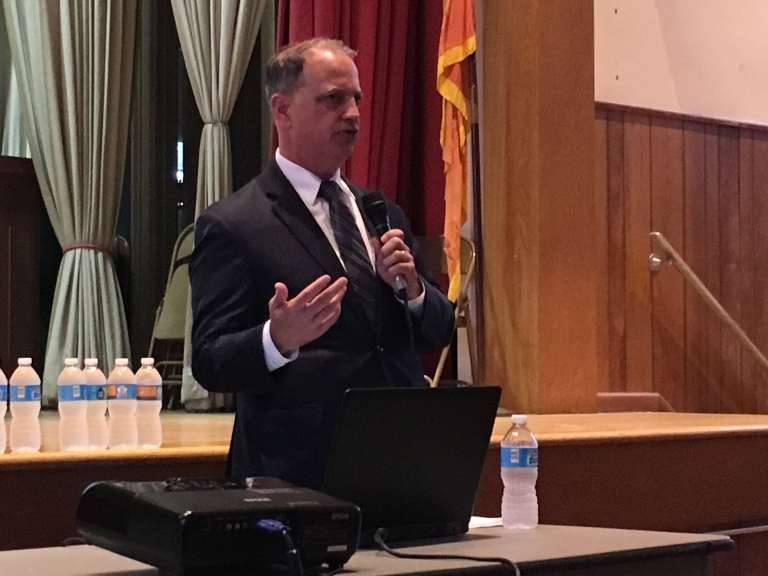
Many New Hyde Park and Floral Park residents still oppose the Long Island Rail Road’s third track project even with recent efforts to address their villages’ concerns.
At a public meeting Thursday night, more than two dozen residents said any efforts to sweeten the deal do not negate the potential harm to those living along the project’s 9.8-mile corridor between Floral Park and Hicksville.
Many also expressed a lack of trust in the LIRR and the Metropolitan Transportation Authority to live up to the memoranda of understanding that project planners are negotiating with village officials.
“Everything in there is sugar on a nasty pill,” Virginia Licari, a New Hyde Park resident, said to the crowd of more than 200 during Thursday’s meeting at the New Hyde Park Road School.
The project, proposed by Gov. Andrew Cuomo, would add a third track to a key stretch of the LIRR’s Main Line, which project officials say would increase railroad capacity and give trains a path around problems on the tracks.
The $2 billion project, estimated to take three to four years to build, would also eliminate seven street-level railroad crossings, upgrade stations and build sound-deflecting walls.
LIRR and state officials have been negotiating a memorandum of understanding with the nine affected municipalities to address local officials’ concerns and ensure accountability during construction, village officials said Thursday.
According to village officials, provisions of the memoranda with New Hyde Park and Floral Park include: a $20 million fund to compensate all municipalities for economic losses; ongoing communication with state officials and the contractor during construction; plans to ensure villages don’t lose parking spaces; and a way for residents to seek compensation for damage to their homes caused during construction.
The negotiations are a way to “balance” the potential harm to traffic, village resources and quality of life that construction could cause, Lawrence Monetruil, the New Hyde Park mayor, said.
“We have not agreed to this. We have not said yes to this. We have not even said that we are happy with” the memorandum so far, Floral Park Mayor Dominick Longobardi said.
Montreuil acknowledged that the project could bring some benefits, especially the elimination of the railroad crossings that back up traffic and endanger pedestrians.
But several residents said they thought planners were only offering these incentives to get local officials to acquiesce to a project that their communities do not want.
Some residents said the memorandum should include more protections and compensation for residents, not just a pot of money for the villages.
For example, the current memoranda says residents would have two years to file claims for damage. Longobardi said local officials want to extend the deadline to 10 years.
Some encouraged Montreuil and Longobardi to sue the MTA and get the project put on hold.
Longobardi said the villages are considering that. New Hyde Park and Floral Park have retained a Manhattan environmental law firm, Beveridge & Diamond, to potentially go to court if their engineering firm, the Vertex Companies, finds the LIRR’s environmental study of the project deficient.
“In my business experience, a memorandum of understanding is only ever done with a party you trust, and I can’t fathom how we possibly trust the MTA to follow through on the particulars,” Julie, a Floral Park resident, said. “… Trust is not negotiated.”
A few residents spoke in support of the project, or at least of the MTA.
One, Claudia Wilson, who said she worked on the MTA’s community outreach effort for the Second Avenue subway in Manhattan, said she believes the authority will live up to its promises.
“It’s going to be awful, but I do think that the MTA will take these concerns seriously, and I think they will help the community as best they can,” Wilson said. Some in the crowd jeered when she finished speaking.
Tony Genovese Jr., a Franklin Square resident, said eliminating the street-level crossings would be a big help to traffic problems in the area.
“It’s horrendous. It’s a death trap,” Genovese said of the crossings. “The system is old. It’s got to be redone.”
Shams Tarek, a spokesman for the project, said local officials and residents have “worked tirelessly” to ensure concerns are addressed. They will continue to be addressed during construction, he said.
“This project will improve LIRR infrastructure and service, expand capacity, reduce local traffic congestion, protect the environment, improve safety, enhance community quality of life, and help improve Long Island’s economic health now and for the next century,” Tarek said in a statement. “That is why the State is doing the project, and why so many Long Islanders support it.”






